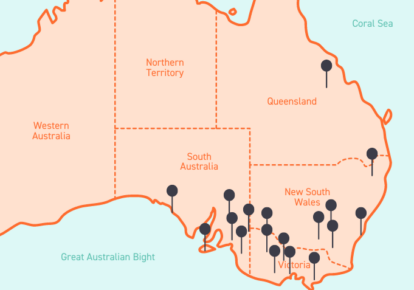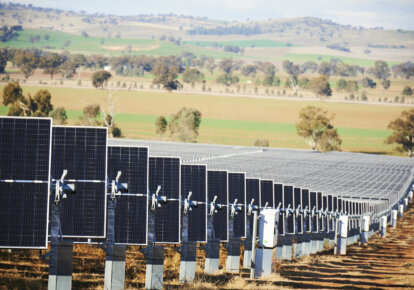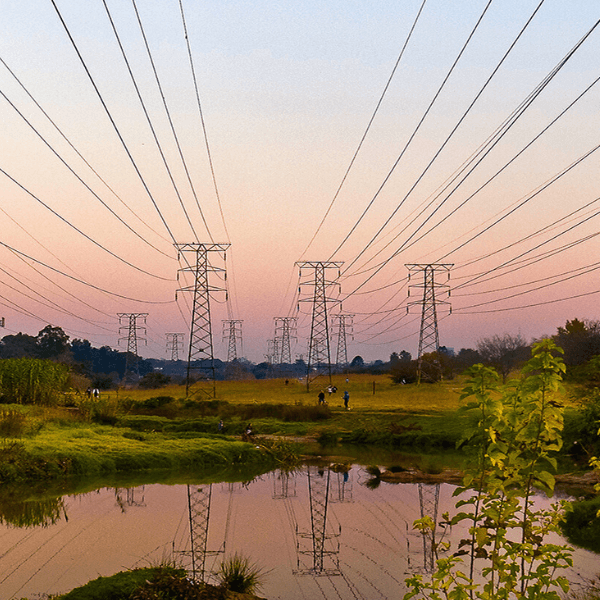In line with recent years, and due to a typical increase in demand and decrease in solar generation, average spot prices increased in May. The most notable event for May was extreme price volatility in New South Wales, resulting in the region hitting the Cumulative Price Threshold on the 8th of May and entering Administered Pricing for a week.
Electricity price insights
May saw average spot prices increase across all NEM regions when compared to previous months. While this may seem like a big jump compared to prices earlier this year, the average price in each region was similar to those of previous Mays in recent years. In addition to a decrease in cheap solar generation, the middle months of the year also bring higher demand, and this higher-demand-lower-supply combination can result in higher electricity prices.
The number of NEM-wide intervals with negative prices continued to drop in May. The most pronounced difference was in South Australia and Victoria which are both typically regions with more negatively priced intervals. Interestingly this trend was not seen in Queensland which had more negatively priced intervals than any of the previous four months, as the warmer month cooling demand drops and the seasonal reduction in solar output is not as pronounced as the southern states.
At this time of year, we typically see increased average demand profiles in Victoria, New South Wales, South Australia, and Tasmania, though a lower average demand profile in Queensland. This is likely a result of the southern states requiring more heating demand as Australia enters winter, and Queensland’s cooling demand from the hotter months reducing. This is not to say that Queensland has no heating demand, rather that contrary to other regions, Queenslanders typically require more cooling than heating through the year. Conversely, Tasmanians typically require more heating than cooling through the year.
Extreme volatility in New South Wales
When reviewing the causes of New South Wales’ extreme prices on May 7th and May 8th, our energy market analysts suggest they occurred for two main reasons: transmission constraints, and unexpected coal outages.
A tube leak on Eraring Unit 2 on May 1st at 11:00 PM reduced New South Wales’ availability by 300 MW. This was an unexpected outage, and the unit returned to service on May 25th. A day later, Unit 3 had another tube leak, which took an additional 700 MW out of NSW until May 9th at 5:00 PM. In the early morning of May 8th, the 650 MW Vales Point 5 generator tripped unexpectedly, and did not return until May 10th at 9:30 PM. The combined effect of these unplanned outages totaled a 1650 MW reduction in New South Wales’ baseload supply.
Starting in April, and persisting for the whole month of May, was an additional outage of a transmission line connecting lower NSW (including Snowy Hydro and the interconnector to VIC) through to Sydney. This outage required AEMO to invoke additional constraints on the system, the primary effect of which was to limit the ability for generation from Southern NSW to help support the greater load in the rest of the state (and importantly, in Sydney where the NSW price is set).
On the day of the Cumulative Price Threshold being reached, the New South Wales/Victoria interconnector was constrained to southern flows into Victoria only, meaning the southern states could not support New South Wales. The two Queensland/New South Wales interconnectors (QNI and Directlink) were flowing south during volatile prices, however there were lower import limit constraints in place.
The leadup to the main events saw 90 minutes of extreme prices in New South Wales with spot prices peaking at the market cap of $16,600 on the evening of May 7th, followed by 90 minutes of extreme prices with spot prices peaking at $16,432 on the morning on May 8th.
Price volatility began in the evening of May 8th at 3:30 PM and spot prices in New South Wales went from $500/MWh to more than $13,000/MWh within 5 minutes. The following 4.5 hours had prices elevated, with many intervals at the market price cap of $16,600/MWh. At 7:55 PM, the Cumulative Price Threshold (CPT) was breached in New South Wales, meaning that the region entered an Administered Price period, capping spot prices at $600/MWh. This was only the second time in history that a CPT event has occurred in NSW.
Primarily as a result of the 8th, May 2024 was the third most expensive month (based on average spot price) for New South Wales on record (with an average spot price of $332/MWh), and May 8th itself was the most expensive day (based on average spot price) in any region on record with an average spot price of $3,554/MWh.
Changes in forward contract prices for FY25
Forward prices for 12-month futures in all mainland regions generally rose throughout May, ending the month about 20% higher than at the end of April.

- New South Wales prices are up 5% from a year ago, and 25% from April 2024
- Queensland prices are up 8% from a year ago, and 15% from April 2024
- South Australia prices are down 7% from a year ago, and up 20% from April 2024
- Victoria prices are down 1% from a year ago, and up 16% from April 2024
May 2024 NEM insights by state
New South Wales

- Average spot price of $274/MWh, with 10 hours of negative prices and 22 hours above $300/MWh (131.31 capped)
- $210/MWh difference in average underlying spot prices at the cheapest and most expensive times of day
- No daily intervals with an average negative price over the whole month
- 27% total renewable generation through the month
- Minimum demand of 5,794 MW
- Peak demand of 10,819 MW
Queensland

- Average spot price of $93/MWh, with 120 hours of negative prices and 4 hours above $300/MWh
- $270/MWh difference between the average underlying prices at the cheapest and most expensive times of day
- Average underlying price was negative from 9:30 AM to 1:00 PM
- 25% total renewable generation through the month
- Minimum demand of 4,096 MW
- Peak demand of 8,134 MW
South Australia

- Average spot price of $136/MWh, with 73 hours of negative prices and 28 hours above $300/MWh
- $200/MWh difference between the average underlying prices at the cheapest and most expensive times of the day
- No daily intervals with an average negative price over the whole month
- 59% total renewable generation through the month
- Minimum demand of 423 MW
- Peak demand of 2,098 MW
Tasmania

- Average spot price of $141.03/MWh, with 9 hours of negative prices and 12 hours above $300/MWh
- $120/MWh difference between lowest and highest time-based average underlying spot price
- No daily intervals with an average negative price over the whole month
- >93% total renewable generation through the month
- New minimum demand record of 784 MW
- Peak demand of 1,666 MW
Victoria

- Average spot price of $133/MWh, with 49 hours of negative prices and 10 hours above $300/MWh
- $180/MWh difference between lowest and highest time-based average underlying spot price
- No daily intervals with an average negative price over the whole month
- 28% total renewable generation through the month
- Minimum demand of 3,020 MW
- Peak demand of 7,520 MW
May temperatures
Much of the NEM had higher maximum, minimum, and mean daily temperatures in May, however coastal South Australia and swathes of southeastern New South Wales and Victoria saw lower-than-average minimum daily temperatures.
Rainfall across Australia was lower-than-average through May, with just one event seeing a band crossing from Northern WA, across Central Australia, to the Southeastern Coast of New South Wales. May continued trending globally for consecutively setting new warm temperature records. This is now the 12th straight month of this trend.
Looking ahead to June
Throughout June, the Bureau of Meteorology has forecast higher-than-usual maximum and minimum temperatures across the NEM. In addition, the Bureau of Meteorology has forecast lower-than-normal rainfall across the NEM (with the effect less pronounced in Eastern Victoria and the southeast New South Wales coast).
In mid-May the Bureau of Meteorology moved to “La Niña Watch” conditions. This does not necessarily guarantee that a shift to La Niña conditions will occur, rather that there are signs it may develop later this year. This would bring cooler than average maximum temperatures across most of mainland Australia (south of the tropics) and increased rainfall.
On the outage front, Origin Energy has scheduled a unit of Eraring to be down for maintenance from the 9th to the 13th of June, and another from the 13th to the 24th of June.
This is typical for operators to stagger outages as to not reduce supply excessively and suddenly. In theory, the planned outage of the latter unit should be dependent on the first unit returning to service.
In terms of shorter outages, the recently returned to service Callide C3 Unit in Queensland is scheduled to be out of service for 2 days in early June, and a unit at Yallourn in Victoria for 2 days mid-month. After a lengthy, more than 1000-day outage, Unit C3 at Callide Power Station in Queensland is forecast to return on June 30th. While its return has been pushed back previously, the June 30th date has been unchanged in recent months. As always, the risk of unplanned outages remains, resulting in reduced capacity at any time.
Any questions? Our energy specialists are here to help.
If you’re an existing Flow Power customer, don’t hesitate to reach out to your account manager.
If you’re not a Flow Power customer, feel free to contact our friendly team:
1300 08 06 08
Alternatively, you can submit your questions through our website contact form here.














